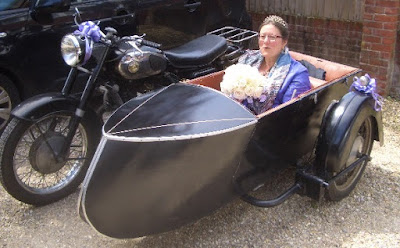The bike is now together and starts ok, the sidecar is reassembled and sprayed and just awaiting the Perspex and rubber for the windows and the chassis is repaired and painted, so what's next. Perhaps I should try the bike up the road.
 |
| In solo form. |
I have a Douglas Dragonfly and a Panther 10/3 both with Earles forks, a leading link design, so this Panther with its home-made leading links should be no problem. I fired it up and set off up the road and was suddenly in fear of my life! The handling was terrible; the bike wanted to fall over. In fifty yards I turned round, carefully, and went back home. I checked it over and decided the head bearings were a bit tight so slackened them off a bit. I also removed the steering damper, then left the machine in the garage for a week to cool off; me not the bike!
On a sunny Sunday I decided to try again and set off up the road and onto the industrial estate, nice wide roads and car parks all completely empty. It went like a dream and handled well if slightly differently than a tele forked machine, but once used to it the bike seemed fine. Only one problem surfaced which I had noticed in moving the bike around. There is a misalignment in the forks as the handlebar is off to one side slightly when running straight ahead. I think the two main fork legs are not bent equally so I shall need to strip the forks and investigate. Otherwise all seem fine.
I stripped out the forks, heated one leg cherry red and tweaked the bend so that it aligned with the other one. When reassembling I set the leading link on the rearmost holes to give the least trail so that should give quick handling on the outfit.
I decided to fit the sidecar chassis. As it came off this bike that should have been easy but all the fittings needed adjustment in thread lengths etc. so it proved to be time consuming. Eventually all was together with about two inches of toe-in and a bit of lean-out. I can't check the handling until the body is on.
 |
| Chassis fitted |
Completion of the sidecar body was delayed as the cut-to-size 3mm Perspex panels didn't arrive. A phone call resulted in two sets of panels, handy as I'd mismeasured one and now had plenty. Finished window panes were cut to shape on a bandsaw using card templates taken from the body panels with allowance for the rubber. The new oval rear window had to be curved and this needed to be heated to about 150 degrees F in the oven to get the curvature right. The two-part rubber was time consuming to fit and needed a special tool and lots of soapy water to insert the sealing strip.
I installed all the lining panels and the door and boot handles and locks. The locks came apart after soaking in diesel and I found some keys which would go in. Any tumblers which stuck out with the key in place were filled off so now the locks work just fine.
For the new roof I sourced some waterproof canvas on Ebay and used an old manual sewing machine to stitch the hems. With new pop fasteners and aluminium gutter trim I managed to achieve a taut soft-top. I found this quite satisfying even though I am incapable of sewing a straight line.
The body was taken into the garage on its trolley and slung from the rafters on ropes so that the chassis could be wheeled beneath it. It was then lowered onto the chassis and bolted down, the holes having been drilled in the floor board to match the chassis before the body was built. That is a lot easier to write than it was to perform.
I applied a Swallow transfer to the nose of the sidecar and a pair of chains to restrain the bootlid. The rear rack and the rusty old silencer came back from the platers and these were fitted and that was about it. I took it up the road and the handling seemed fine although the trip was curtailed by a blockage in the fuel system which gave me a 600 yard push home, rather knackering!
All in all the Wreck has been turned into quite a presentable outfit. I like the sidecar very much and will probably keep it but I intend to pass the bike and chassis on with a different body fitted. There are one or two minor points to address; the tank has sprung a pinhole leak despite the new lining, the back light is not working, and I need to make a number plate and get it taxed. Generally the whole thing needs shaking down to give a reliable ride.
 |
| Boot interior. |
 |
| New interior, the seat back is original. |
There is no more to be said, except ...
THE END.




























































